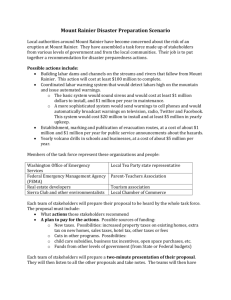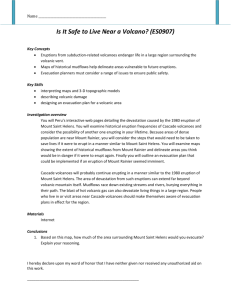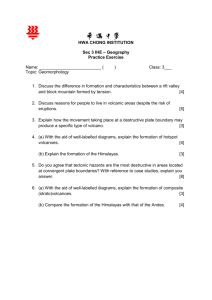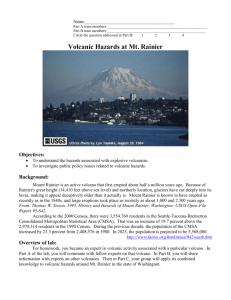Web Extras for Chapter 3: Igneous Rocks
advertisement
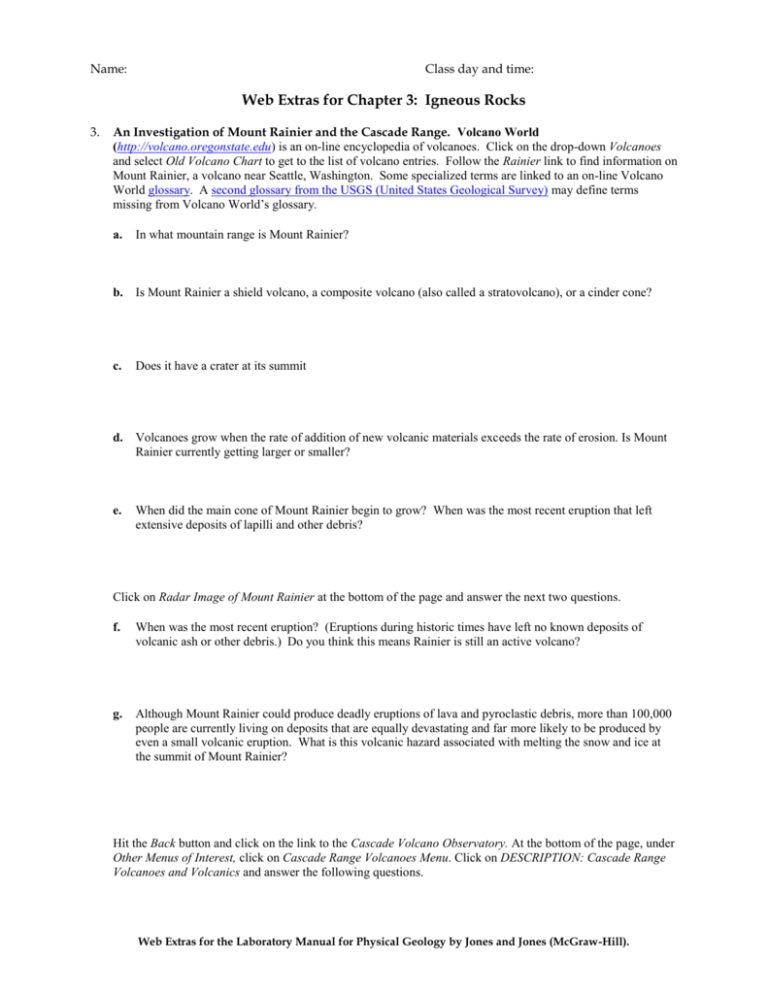
Name: Class day and time: Web Extras for Chapter 3: Igneous Rocks 3. An Investigation of Mount Rainier and the Cascade Range. Volcano World (http://volcano.oregonstate.edu) is an on-line encyclopedia of volcanoes. Click on the drop-down Volcanoes and select Old Volcano Chart to get to the list of volcano entries. Follow the Rainier link to find information on Mount Rainier, a volcano near Seattle, Washington. Some specialized terms are linked to an on-line Volcano World glossary. A second glossary from the USGS (United States Geological Survey) may define terms missing from Volcano World’s glossary. a. In what mountain range is Mount Rainier? b. Is Mount Rainier a shield volcano, a composite volcano (also called a stratovolcano), or a cinder cone? c. Does it have a crater at its summit d. Volcanoes grow when the rate of addition of new volcanic materials exceeds the rate of erosion. Is Mount Rainier currently getting larger or smaller? e. When did the main cone of Mount Rainier begin to grow? When was the most recent eruption that left extensive deposits of lapilli and other debris? Click on Radar Image of Mount Rainier at the bottom of the page and answer the next two questions. f. When was the most recent eruption? (Eruptions during historic times have left no known deposits of volcanic ash or other debris.) Do you think this means Rainier is still an active volcano? g. Although Mount Rainier could produce deadly eruptions of lava and pyroclastic debris, more than 100,000 people are currently living on deposits that are equally devastating and far more likely to be produced by even a small volcanic eruption. What is this volcanic hazard associated with melting the snow and ice at the summit of Mount Rainier? Hit the Back button and click on the link to the Cascade Volcano Observatory. At the bottom of the page, under Other Menus of Interest, click on Cascade Range Volcanoes Menu. Click on DESCRIPTION: Cascade Range Volcanoes and Volcanics and answer the following questions. Web Extras for the Laboratory Manual for Physical Geology by Jones and Jones (McGraw-Hill). h. Which states and Canadian province host the Cascade Range volcanoes? i. List several other volcanoes in the Cascade Range. j. Explain, in terms of plate-tectonic theory, why Mount Rainier and the other Cascade volcanoes are there. k. Which rock compositions (such as basalt or granite) are the most common in the Cascades volcanoes?. Another volcano website of interest is http://satftp.soest.hawaii.edu/space/hawaii/virtual.field.trips.html, which features virtual field trips of the Hawaiian Islands. The Big Island of Hawaii features the most volcanic features. If you would like to see beautiful photomicrographs of igneous and metamorphic rocks, try hunting around http://www.geolab.unc.edu/Petunia/IgMetAtlas/mainmenu.html. Web Extras for the Laboratory Manual for Physical Geology by Jones and Jones (McGraw-Hill).

